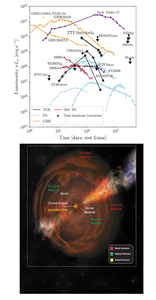A New Type of Cosmic Explosion
 The authors discuss ZTF18abvkwla (the "Koala"), a fast blue optical transient (FBOT) discovered in the Zwicky Transient Facility (ZTF) One-Day Cadence (1DC) Survey. ZTF18abvkwla has features in common with the groundbreaking transient AT 2018cow: blue colors at peak light, a short rise time from half-max of under two days, a decay time to half-max of only three days, a high optical luminosity, a hot featureless spectrum at peak light, and a luminous radio counterpart. At late times (Dt > 80 days), the radio luminosity of ZTF18abvkwla at 10 GHz is most similar to that of long-duration gamma-ray bursts (GRBs). The host galaxy is a dwarf starburst galaxy (M ~ 5 x 108 M⊙ and SFR ~ 7 M⊙ per year) that is moderately metal-enriched (log[O/H] ~ 8.5), similar to the hosts of Gamma Ray Bursts (GRBs) and superluminous supernovae.
The authors discuss ZTF18abvkwla (the "Koala"), a fast blue optical transient (FBOT) discovered in the Zwicky Transient Facility (ZTF) One-Day Cadence (1DC) Survey. ZTF18abvkwla has features in common with the groundbreaking transient AT 2018cow: blue colors at peak light, a short rise time from half-max of under two days, a decay time to half-max of only three days, a high optical luminosity, a hot featureless spectrum at peak light, and a luminous radio counterpart. At late times (Dt > 80 days), the radio luminosity of ZTF18abvkwla at 10 GHz is most similar to that of long-duration gamma-ray bursts (GRBs). The host galaxy is a dwarf starburst galaxy (M ~ 5 x 108 M⊙ and SFR ~ 7 M⊙ per year) that is moderately metal-enriched (log[O/H] ~ 8.5), similar to the hosts of Gamma Ray Bursts (GRBs) and superluminous supernovae.
As in AT2018cow, the radio and optical emission in ZTF18abvkwla likely arises from two separate components: the radio from fast-moving ejecta and the optical from shock-interaction with confined dense material. These FBOTs likely begin the same way as certain supernovae and gamma-ray bursts. The differences are seen in the aftermath of the initial explosion. FBOTS are much brighter than supernovae, but not as bright as GRBs, suggesting a mildly relativistic jet engine in a dense environment. The authors find that transients in the FBOT rise-luminosity phase space are at least two to three orders of magnitude less common than core-collapse supernovae. They discuss strategies for identifying such events with future facilities such as the Vera C. Rubin Observatory, as well as prospects for detecting accompanying X-ray and radio emission.
Figure caption: [Top] Radio light curves for several cosmic explosion types. The Koala is marked with an arrow. The FBOTS (black stars) are all much brighter than supernovae, but not as bright as GRBs, suggesting a mildly relativistic jet engine in a dense environment. [Bottom] Artist’s impression of an FBOT.
Publication: Anna Ho (California Institute of Technology) et al., The Koala: A Fast Blue Optical Transient with Luminous Radio Emission from a Starburst Dwarf Galaxy at z=0.27, Astrophysical Journal, 895, 49 (26 May 2020).
NRAO Press Release: Astronomers Discover New Class of Cosmic Explosions




Connect with NRAO